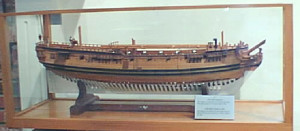Location: Gun Deck
During the Age of the Wooden Walls of England, British warships were classified in size by the numbers of guns they were “rated” to carry. The actual number of the large caliber guns carried sometimes exceeded the rating (nor did anyone count the carronades mounted on the weather deck). Nevertheless, the rating method describing ships remained in effect until the age of steam and the modern warship. There were six rates. A first rate was a ship rated for more than 100 guns. A sixth rate was a ship of 20 guns or less. So HMS Seahorse was carrying 16 guns more than provided for by her rating.
Originally, these small frigates were used for patrolling, scouting, transmitting messages or messengers and anti-smuggling duty. They were small, seaworthy ships able to police areas for privateers or pirates. Depending on the duty, they would sail with a crew of 150 or 200 men, far smaller than the big, slow, cumbersome ships of the line. Sixth rates were a place where young career men could learn seamanship, hone their skills and gain a broad range of experience that would lead to higher rank and responsibility.
The Royal Navy’s Seahorse, Sixth Rate, laid down in 1748, was not the first ship of that name. There were six predecessors and there were to be four successors, including the last sunk by a submarine in 1940.
This version of Seahorse was built in Harwich, Suffolk, England, in 1748 and went out of service in 1798. During that period, typical of her class, she served on various British stations around the world. She gained her fame as the first warship in which Nelson sailed as a midshipman.
The Model
This model is one of several in the museum that are only partially enclosed to illustrate the construction of wooden warships.
Scale: ¼” H 15 ½” L 36” W 14”
Plank on frame, built by James Cutler, circa 1960
Source: Colin Denny, Ltd GB 1988
